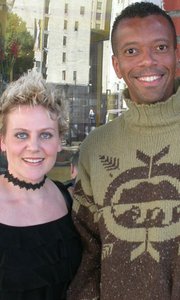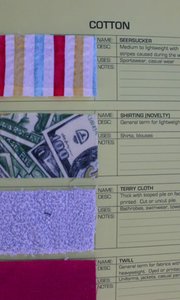A New Approach to Identifying Textiles
Learning about fabric isn’t always about Xs and Os. That’s why Los Angeles-based designers James Darren Clay and Victoria Woodford developed the Fabric Swatch Kit, a learning tool for design students and other apparel-industry apprentices.
Clay and Woodford are taking a different tack to teaching fabric know-how. Rather than concentrating on technical aspects such as chemical composition, constructions and weaves, they are focusing on style, function and form—something that existing books overlook, they said.
While construction and weave are important, feel, design and “real world” considerations are more pertinent to 21st century design and textile students, Woodford said.
“We want to inform but also inspire,” she explained. “With things like sublimation printing, there’s lots of interesting stuff out there.”
The designers pooled their resources to develop the kit after seeing a void in the approximately 750 fashion campuses across the country. Other kits do not categorize fabrics or explain how they are worn, said Woodford.
“It’s a learn-as-you-go process,” she explained.
Woodford, a former Fashion Institute of Design & Merchandising (FIDM) design student of the year, and Clay, a FIDM teacher and designer, said that campuses are in need of more creative-based resources.
“It’s something that’s missing—nobody has done anything about it,” said Woodford.
In the age of microfibers, Tencel and other relatively new materials, it pays to know your fabrics, especially since fabric is a big part of fashion knowledge, added Clay.
The pair combed the local fabric market to put together the swatch kit, which consists of 175 loose fabric pieces that students catalog into a loose-leaf binder. The kit makes students do the work, so they get a hands-on examination of the fabrics, said Woodford. It also is categorized into sections for cotton, linen, silk, wool, polyester, rayon, knits, linings, treatments and blends. Users can write in information about the fabrics’ uses as they pertain to the market.
“You can have a wool but have no idea what kind of wool you’re dealing with,” said Clay. “This is a great resource to identify all types of textiles.”
The designers will expand the kit eventually to include price categorizations to help students understand that element of the apparel game.
Clay and Woodford are working with Los Angeles incubator group Fashion Business Inc. (FBI) to promote the kit, offering FBI members 25 percent off the $100 list price. The kit is also available at the Fashion Bookstore in the California Market Center or at www.clayhunterinc.com. —Robert McAllister























